Plum pudding - Study guides, Revision notes & Summaries
Looking for the best study guides, study notes and summaries about Plum pudding? On this page you'll find 253 study documents about Plum pudding.
Page 2 out of 253 results
Sort by
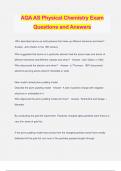
-
AQA AS Physical Chemistry Exam Questions and Answers
- Exam (elaborations) • 45 pages • 2024
-
- £10.74
- + learn more
AQA AS Physical Chemistry Exam Questions and Answers Who described atoms as solid spheres that make up different elements and when? - Answer- John Dalton in the 19th century Who suggested that atoms of a particular element had the same mass and atoms of different elements had different masses and when? - Answer- John Dalton in 1803 Who discovered the electron and when? - Answer- JJ Thomson, 1897 discovered electrons proving atoms weren't indivisible or solid. New model named plum puddin...
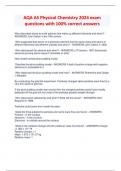
-
AQA AS Physical Chemistry 2024 exam questions with 100% correct answers
- Exam (elaborations) • 29 pages • 2024
- Available in package deal
-
- £11.13
- + learn more
AQA AS Physical Chemistry 2024 exam questions with 100% correct answers Who described atoms as solid spheres that make up different elements and when? - ANSWERS John Dalton in the 19th century Who suggested that atoms of a particular element had the same mass and atoms of different elements had different masses and when? - ANSWERS John Dalton in 1803 Who discovered the electron and when? - ANSWERS JJ Thomson, 1897 discovered electrons proving atoms weren't indivisible or solid. New m...
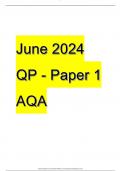
-
June 2024 QP - Paper 1 AQA Chemistry AS-level
- Exam (elaborations) • 57 pages • 2024
-
- £4.61
- + learn more
Section A Answer all questions in this section. 0 1 This question is about atomic structure. In the nineteenth century JJ Thomson discovered the electron. He suggested that negative electrons were found throughout an atom like ‘plums in a pudding of positive charge’. Figure 1 shows an atom of element R using the ‘plum pudding’ model. An atom of R contains seven electrons. Figure 1 0 1 . 1 State two differences between the ‘pl...
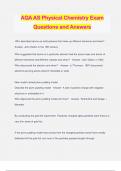
-
AQA AS Physical Chemistry Exam Questions and Answers
- Exam (elaborations) • 45 pages • 2024
-
- £10.74
- + learn more
AQA AS Physical Chemistry Exam Questions and Answers Who described atoms as solid spheres that make up different elements and when? - Answer- John Dalton in the 19th century Who suggested that atoms of a particular element had the same mass and atoms of different elements had different masses and when? - Answer- John Dalton in 1803 Who discovered the electron and when? - Answer- JJ Thomson, 1897 discovered electrons proving atoms weren't indivisible or solid. New model named plum puddin...
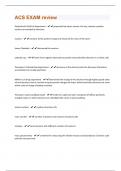
-
ACS EXAM review Questions And Answers Verified 100% Correct!!
- Exam (elaborations) • 15 pages • 2023
- Available in package deal
-
- £6.36
- + learn more
Rutherford's Gold Foil Experiment - proposed that atoms consist of a tiny, massive, positive nucleus surrounded by electrons nucleus - contains all the positive charge and nearly all the mass of the atom James Chadwick - discovered the neutron cathode rays - move from negative electrode to positive electrode (like electrons in a voltaic cell) Thompson's Cathode Ray Experiment - discovery of the electron (also the discovery that atoms are divisible into smaller particles) Millikin's oil...
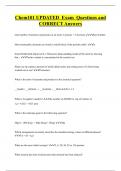
-
Chem101 UPDATED Exam Questions and CORRECT Answers
- Exam (elaborations) • 28 pages • 2024
-
- £6.76
- + learn more
total number of neutrons and protons in an atom; # protons + # electrons Mass Number Most nonmetallic elements are found in which block of the periodic table? p Ernest Rutherford disproved J.J. Thomson's plum-pudding model of the atom by showing that... Positive matter is concentrated in the central core Plants use up copious amounts of which alkali metal, preventing most of it from being washed out to sea? Potassium What is the ratio of reactants and products in the chemical equation? ...
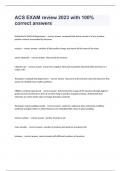
-
ACS EXAM review 2023 with 100% correct answers
- Exam (elaborations) • 15 pages • 2023
-
- £12.33
- + learn more
Rutherford's Gold Foil Experiment - correct answer proposed that atoms consist of a tiny, massive, positive nucleus surrounded by electrons nucleus - correct answer contains all the positive charge and nearly all the mass of the atom James Chadwick - correct answer discovered the neutron cathode rays - correct answer move from negative electrode to positive electrode (like electrons in a voltaic cell) Thompson's Cathode Ray Experiment - correct answer discovery of the ele...
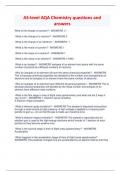
-
AQA AS Physical Chemistry 2024 exam questions with 100% correct answers
- Exam (elaborations) • 16 pages • 2024
-
- £11.53
- + learn more
AQA AS Physical Chemistry 2024 exam questions with 100% correct answers Who described atoms as solid spheres that make up different elements and when? - ANSWERS John Dalton in the 19th century Who suggested that atoms of a particular element had the same mass and atoms of different elements had different masses and when? - ANSWERS John Dalton in 1803 Who discovered the electron and when? - ANSWERS JJ Thomson, 1897 discovered electrons proving atoms weren't indivisible or solid. New m...
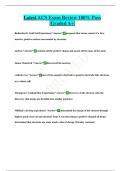
-
Latest ACS Exam Review 100% Pass |Graded A+|
- Exam (elaborations) • 21 pages • 2024
- Available in package deal
-
- £7.55
- + learn more
Latest ACS Exam Review 100% Pass |Graded A+| Rutherford's Gold Foil Experiment *Answer* proposed that atoms consist of a tiny, massive, positive nucleus surrounded by electrons nucleus *Answer* contains all the positive charge and nearly all the mass of the atom James Chadwick *Answer* discovered the neutron cathode rays *Answer* move from negative electrode to positive electrode (like electrons in a voltaic cell) Thompson's Cathode Ray Experiment *Answer* discovery of the electron ...
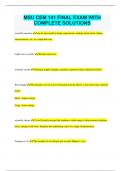
-
MSU CEM 141 FINAL EXAM WITH COMPLETE SOLUTIONS
- Exam (elaborations) • 42 pages • 2024
- Available in package deal
-
- £9.14
- + learn more
MSU CEM 141 FINAL EXAM WITH COMPLETE SOLUTIONS scientific question can be answered by doing experiments, making observation, taking measurements, etc. in a replicable way Lights acts as what? Particle and wave. scientific model drawing, graph, diagram, equation. represent many chemical entities. Wavelength The distance (m) of waves from peak to peak. Short: x-ray (red), long: infrared (blue) Short - higher energy Long - lower energy scientific theory A well tested concept t...

How did he do that? By selling his revision notes on Stuvia. Try it yourself! Discover all about earning on Stuvia


